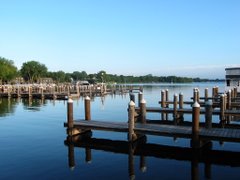After their discovery this summer, the shock of zebra mussels in Lake Minnetonka has diminished. And while the full impacts of zebra mussel in our lake are yet to come, we must now turn our attention and prevention efforts to the other aquatic invasive species (AIS) that are coming our way.
The Minnesota Invasive Species Advisory Council has identified these AIS that are in Minnesota or are expected to be in Minnesota that represent a serious threat:
Plants - Brazilian waterweed, Brittle naiad, European frog-bit, Giant salvinia, Hardy hybrid water lily, Hydrilla, Phragmites, Salt-cedar, Water chestnut, Water hyacinth, Water lettuce, Yellow iris. Animals -Asian carp (bighead, black, grass, silver), Faucet snail, Mute swan, Mystery snails (Chinese, Japanese, banded), New Zealand mud snail, Northern snakehead, Quagga mussel, Round goby, Ruffe, Rusty crayfish, Sea lamprey, Spiny waterflea. Pathogens - viral hemorrhagic septicemia (VHS).
Lake Minnetonka is already home to these unwanted invaders: Common carp, curlyleaf pondweed, Eurasian watermilfoil, Flowering rush, zebra mussel and largemouth bass virus. Of these, only two species – milfoil and curlyleaf pondweed – are even attempted to be controlled or managed.
I have worked on lake issues around the country for over thirty years and in my opinion AIS issues and their impacts to lakes represent the most profound pollution challenge we have yet seen. As bad as lake pollution concerns were in the 1960s (remember ‘Lake Erie is dead’ ?), at least these impacts were reversed. With AIS, the impacts are permanent and accumulate as each new species is added to a lake.
From the list above, three species are of immediate concern:
Spiny waterflea – a small animal (about 3/8-inch long) that has a spiny tail that clings to fishing lines, anchor ropes and other equipment. Spiny waterflea reproduces rapidly and produces eggs that are resistant to drying. In addition to being a nuisance for anglers and boaters, this animal feeds at the base of the food chain, thereby robbing fish of their food base. Spiny waterflea are in Mille Lacs Lake and Lake Minnetonka is frequently visited by boaters from Mille Lacs.
VHS – a virus that causes fish kills en masse. VHS has caused large-scale mortality in black crappie, bluegill, freshwater drum, muskellunge and yellow perch and has also been confirmed to have caused kills of smallmouth bass and walleye. VHS is transported in contaminated fish and contaminated water and equipment. VHS is in Lake Superior.
Hydrilla – an invasive plant that is so aggressive, it has been known to out-compete milfoil. Hydrilla spreads rapidly and is difficult to control. Hydrilla has been found in Wisconsin and has been established in northern Indiana.
The Lake Minnetonka Association is extremely concerned about these (and other) new AIS because:
1) Each new invasion brings its own impacts plus the combined impacts with AIS already in the lake.
2) The inspections we had on Lake Minnetonka before the discovery of zebra mussel last year were not adequate in the first place – only about a quarter of incoming boats at public launches were inspected.
3) When zebra mussels were discovered in Lake Minnetonka, a significant amount of the planned inspections for incoming boats was either discontinued or re-directed to outgoing boats, leaving Lake Minnetonka more exposed.
4) We had become so focused on preventing zebra mussel that we had minimized the threat of other new AIS.
As additional AIS are introduced into Lake Minnetonka, their impacts will not just be additive, they will be synergetic. Simply, this means that one plus one will not equal two, it will equal three or even more. The fancy ecological term for this is the ecosystem will have less integrity and we risk undoing many years of positive clean up. In real terms, Lake Minnetonka will become less clean and less habitable for fish and wildlife.
Like it or not, zebra mussels are here to stay, but let’s not let down our guard.
Let’s let this awful lesson guide us and compel us to protect Lake Minnetonka from the next onslaught.
Tuesday, February 15, 2011
Subscribe to:
Posts (Atom)

